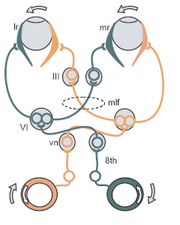Assessment |
Biopsychology |
Comparative |
Cognitive |
Developmental |
Language |
Individual differences |
Personality |
Philosophy |
Social |
Methods |
Statistics |
Clinical |
Educational |
Industrial |
Professional items |
World psychology |
Clinical: Approaches · Group therapy · Techniques · Types of problem · Areas of specialism · Taxonomies · Therapeutic issues · Modes of delivery · Model translation project · Personal experiences ·
Internuclear_ophthalmoplegia.jpg|
| ICD-10 | H512 | |
|---|---|---|
| ICD-9 | 378.86 | |
| OMIM | [1] | |
| DiseasesDB | 6853 | |
| MedlinePlus | [2] | |
| eMedicine | / | |
| MeSH | {{{MeshNumber}}} | |
Internuclear ophthalmoplegia (INO) is a disorder of conjugate lateral gaze in which the affected eye shows impairment of adduction. When an attempt is made to gaze contralaterally (relative to the affected eye), the affected eye adducts minimally, if at all. The contralateral eye abducts, however with nystagmus. Additionally, the divergence of the eyes leads to horizontal diplopia. That is, if the right eye is affected the patient will "see double" when looking to the left, seeing two images side-by-side. Convergence is generally preserved.
Causes[]

The disorder is caused by injury or dysfunction in the medial longitudinal fasciculus (MLF), a heavily-myelinated tract that allows conjugate eye movement by connecting the paramedian pontine reticular formation (PPRF)-abducens nucleus complex of the contralateral side to the oculomotor nucleus of the ipsilateral side.
In young patients with bilateral INO, multiple sclerosis is often the cause. In older patients with one-sided lesions a stroke is a distinct possibility. Other causes are possible.[1]
Variants[]
A rostral lesion within the midbrain may affect the convergence center thus causing bilateral divergence of the eyes which is known as the WEBINO syndrome ( Wall Eyed Bilateral INO)[2] as each eye looks at the opposite "wall".
If the lesion affects the Paramedian pontine reticular formation PPRF (or the abducens nucleus) and the MLF on the same side (the MLF having crossed from the opposite side), then the "one and a half syndrome" occurs which, simply put, involves paralysis of all conjugate horizontal eye movements other than abduction of the eye on the opposite side to the lesion.
See also[]
- Multiple sclerosis
- One and a half syndrome
References[]
- ↑ Keane JR (May 2005). Internuclear ophthalmoplegia: unusual causes in 114 of 410 patients. Arch. Neurol. 62 (5): 714–7.
- ↑ Lana MA, Moreira PR, Neves LB (December 1990). Wall-eyed bilateral internuclear ophthalmoplegia (Webino syndrome) and myelopathy in pyoderma gangrenosum. Arq Neuropsiquiatr 48 (4): 497–501.
External links[]
- GPnotebook 1611005961
- Animation at mrcophth.com
Eye disease - pathology of the eye (H00-H59, 360-379) | |||||||||||||||
|---|---|---|---|---|---|---|---|---|---|---|---|---|---|---|---|
| Adnexa |
eyelid: inflammation (Stye, Chalazion, Blepharitis) - Entropion - Ectropion - Lagophthalmos - Blepharochalasis - Ptosis - Blepharophimosis - Xanthelasma - Trichiasis - Madarosis lacrimal system: Dacryoadenitis - Epiphora - Dacryocystitis orbit: Exophthalmos - Enophthalmos | ||||||||||||||
| Eyeball |
| ||||||||||||||
| Optic nerve and visual pathways |
Optic neuritis - Papilledema - Optic atrophy - Leber's hereditary optic neuropathy - Dominant optic atrophy - Optic disc drusen - Glaucoma - Toxic and nutritional optic neuropathy - Anterior ischemic optic neuropathy | ||||||||||||||
| Ocular muscles, binocular movement, accommodation and refraction |
Paralytic strabismus: Ophthalmoparesis - Progressive external ophthalmoplegia - Palsy (III, IV, VI) - Kearns-Sayre syndrome
Other strabismus: Esotropia/Exotropia - Hypertropia - Heterophoria (Esophoria, Exophoria) - Brown's syndrome - Duane syndrome | ||||||||||||||
| Visual disturbances and blindness |
Amblyopia - Leber's congenital amaurosis - Subjective (Asthenopia, Hemeralopia, Photophobia, Scintillating scotoma) - Diplopia - Scotoma - Anopsia (Binasal hemianopsia, Bitemporal hemianopsia, Homonymous hemianopsia, Quadrantanopia) - Color blindness (Achromatopsia, Dichromacy, Monochromacy) - Nyctalopia (Oguchi disease) - Blindness/Low vision | ||||||||||||||
| Pupil |
Anisocoria - Argyll Robertson pupil - Marcus Gunn pupil/Marcus Gunn phenomenon - Adie syndrome - Miosis - Mydriasis - Cycloplegia | ||||||||||||||
| Infectious diseases |
Trachoma - Onchocerciasis | ||||||||||||||
| Other |
Nystagmus - Glaucoma/Ocular hypertension - Floater - Leber's hereditary optic neuropathy - Red eye - Keratomycosis - Xerophthalmia - Phthisis bulbi | ||||||||||||||
|
See also congenital | |||||||||||||||
Lesions of spinal cord and brain | |||||||||||
|---|---|---|---|---|---|---|---|---|---|---|---|
| Spinal cord/ vascular myelopathy |
| ||||||||||
| Brainstem |
| ||||||||||
| Cerebellum |
| ||||||||||
| Basal ganglia | |||||||||||
| Cortex |
| ||||||||||
| Thalamus | |||||||||||
| Other |
| ||||||||||
| {| class="navbox collapsible nowraplinks" style="margin:auto; " | |||||||||||
| |||||||||||
|}